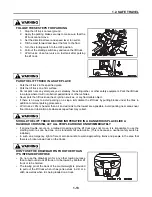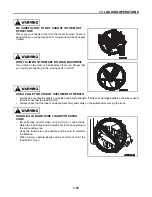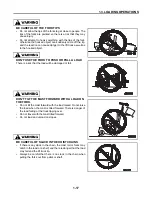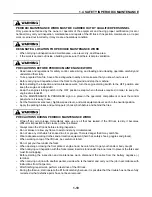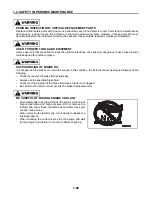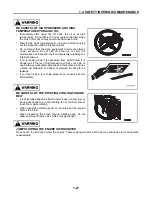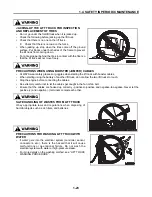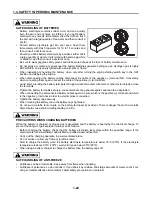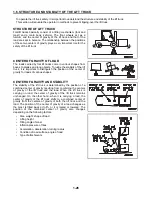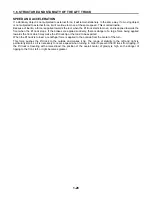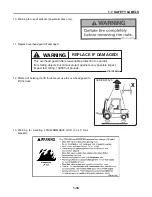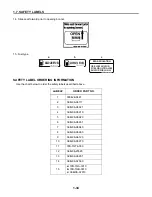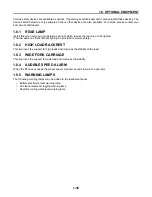
1.6. STRUCTURE AND STABILITY OF THE LIFT TRUCK
1-27
STABLE RANGE OF CENTER OF GRAVITY
For the lift truck to remain stable, the combined center of gravity
of the lift truck must come within a stable range of the center of
gravity, i.e. a triangle formed by three points of the right and left
front wheels in contact with the floor and the center of the rear
axle.
When a position of the combined center of gravity shifts beyond
the front axle, the lift truck will tip over in the forward direction with
the front wheels acting as a fulcrum. On the other hand, when a
position of the combined center of gravity shifts outside of a
stable range of the center of gravity, the lift truck will overturn in
the direction of shifting.
ACTUAL CAPACITY
The horizontal distance from the position of the center of gravity
of a load on the fork to the upright load backrest of the fork is
called a load center.
Actual capacity means the maximum weight of a load that can be
loaded at a certain load center.
A load capacity chart is given in the name plate. The chart shows
the relationship between the actual capacity and a load center.
As a load center shifts toward the fork tips, so does the position of
the combined center of gravity, too. Therefore, the load has to be
decreased accordingly in the actual operation.
When the lift truck is equipped with an attachment, or when the mast is raised high, the actual capacity is reduced.
Take this fact into consideration in such a case.
LOAD CAPACITY CHART
In the load capacity chart, capacity is shown in relation to load center.
Capacity values are determined according to each model on the
condition of the specifications shown on the plate.
Before proceeding to loading a load, make sure that the load center
and the load are well within the confines of capacity.
When the load is in a complex shape, pull the load closer to the load
backrest so that the heaviest portion of the load comes to the fork
center.
Should a load be loaded beyond the confines of capacity, it would pose a serious danger to the lifting truck as the
rear wheels (for steering) are likely to lift off the ground, causing the operator to lose control of steering.
To make the things still worse, the lift truck will likely tip over while in operation. Therefore, always make sure that
the load is absolutely within the confines of capacity.
LOAD CENTER AND ACTUAL CAPACITY
A nameplate shown at right is just an example. In the actual
operation, follow the instructions on a nameplate of the actual lift
truck.
An example here shows a nameplate for a lift truck which has a
mast of max. fork height of 3.0 m and which is not equipped with any
attachment.
Even when the load center is shorter than 500 mm, the actual capacity is 2,500 kg (2).
It is required to replace the present nameplate with a new one when the present nameplate is broken or has
become difficult to read. In that case, call your Komatsu Forklift dealer asking for a new replacement nameplate.
(1) When the load center is 500 mm
(2) Capacity: 2,500 kg
(1) When the load center is 600 mm
(2) Capacity: 2,250 kg
(1) When the load center is 1,000 mm (2) Capacity: 1,620 kg
Summary of Contents for CX20 Series
Page 21: ...1 SAFETY...

